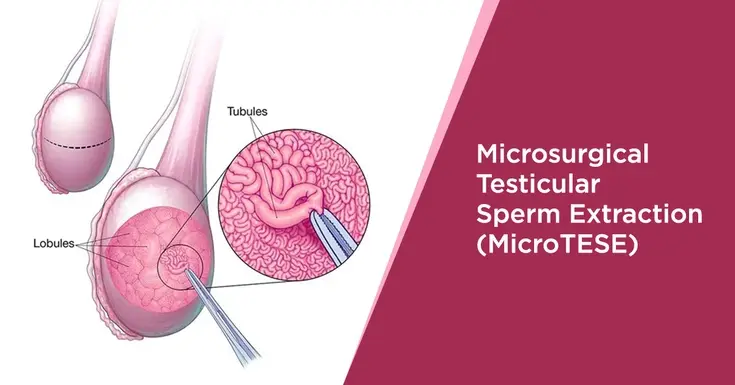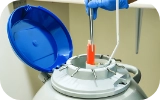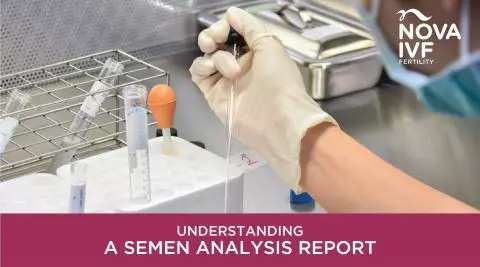MicroTESE Procedure: Key Facts You Should Know

About Microsurgical Testicular Sperm Extraction (MicroTESE) Procedure
Infertility can be a distressing phenomenon for those affected by it. IVF is a treatment option for infertility. However, male infertility needs an advanced IVF technique called ICSI as some men may not be able to give enough sperms for conventional IVF. Fewer men still, fail to produce enough sperms for ICSI too. This populace needs to undergo surgical sperm recovery through methods like PESA, TESA to obtain sperm directly from the testes. In the rarest instances, even surgical sperm recovery methods may fail due to extreme paucity of sperms. They can benefit from Micro-TESE which is an advanced method of surgical sperm recovery in men who fail to give sperms in conventional methods of sperms recovery. While there are various modules of IVF treatment, MicroTESE has emerged as the most popular and reasonable procedure when compared with other available options. Let us try and understand more about this revolutionary procedure.
What is MicroTESE?
MicroTESE or Microsurgical Testicular Sperm Extraction refers to a surgical procedure used to retrieve sperm from a male testis. It is considered as one of the most effective methods of sperm retrieval and is performed mainly in cases of severe infertility like azoospermia (inability to produce sperm). MicroTESE is carefully coordinated with the reproductive endocrinologist and performed at designated times on a quarterly basis.
When is it recommended?
MicroTESE is performed in men who are diagnosed with Non-Obstructive Azoospermia (NOA), which refers to a condition where the semen contains a negligible amount of sperm. It may occur either due to an intrinsic failure in the testis or inadequate production of hormones like gonadotropin, which are essential during the process of spermatogenesis (development of mature spermatozoa).
How does MicroTESE help with NOA?
Although the sperm count is zero or undetectable in NOA; however, in 60 percent of the cases, there may be minute areas within the testis that still produce the sperm. These tubules can be accessed with MicroTESE to retrieve a desired amount of sperm.
How is MicroTESE performed?
MicroTESE is a procedure performed for men who have a problem in sperm production and are azoospermic. This procedure is performed in the operating room with general anesthesia under the operating microscope. MicroTESE is carefully coordinated with the female partner’s egg retrieval and is performed the day before egg retrieval. This allows for each partner to be present during their partner’s procedure. MicroTESE has significantly improved sperm retrieval rates in azoospermic men and is a safer procedure since less testicular tissue is removed. The sperm retrieved during MicroTESE can also be cryopreserved for future IVF/ICSI.
MicroTESE is performed as an outpatient procedure (no overnight stay necessary) by a specialist like a urologist or an andrologist. It is carried out either under local or general anesthesia. A small incision, about 2-3 cm, is made in the middle of the testicle to gain access to the scrotal tissues. Following this, a surgical microscope with 40x magnification is placed over the operating field to search for and examine seminiferous tubules (which are a small network of tubes that contain sperm. The tubules which contain sperm are usually enlarged - these tubules are identified and extracted until a sufficient amount is collected. The collected sperm is then transferred for assisted fertility procedures or cryopreservation for later use. It is important to note here that MicroTESE is always performed along with ICSI or IntraCytoplasmic Sperm Injection, which is essentially when a single, viable sperm is injected directly into the egg.
What are the advantages of microTESE?
MicroTESE is widely accepted as a superior form of sperm retrieval compared to the conventional infertility treatments. Studies show that the sperm retrieved from microTESE is usually of better quality in terms of sperm motility and is also higher in quantity. The success rate with MicroTESE is very favorable - nearly 40-60% obtain great results from the procedure.
Some other advantages include:
- Minimal pain and fast recovery post-surgery
- Better chances of cryo-preservation of the sperm after retrieval
- Fewer chronic changes to the scrotal tissues
Post-surgery care and recovery
Most men recover quite quickly following the MicroTESE procedure as the scrotal tissues heal comparatively faster. The Majority of patients experience minimal postoperative pain. However, your doctor may still prescribe some painkillers to ease your recovery period. Following the surgery, you may have to use a local ice pack for the next 24 hours to avoid any postoperative swelling or pain. It is also advisable to refrain from performing any strenuous physical activities up to 10 days post-surgery.
Are there any complications associated with MicroTESE?
MicroTESE is a minor surgical procedure with minimal complications. Most complications that arise post-MicroTESE can be treated conservatively. Some complications include hematoma, bleeding, or testicular damage.
By Dr. Rohit Gutgutia
Medical Director
Nova IVF Fertility, Kolkata
 Infertility Counselling
Infertility Counselling Female Infertility Treatment
Female Infertility Treatment Andrology Treatment
Andrology Treatment Fertility Enhancing Surgeries - Female
Fertility Enhancing Surgeries - Female Fertility Enhancing Surgeries - Male
Fertility Enhancing Surgeries - Male Endoscopy Treatment
Endoscopy Treatment IUI Treatment
IUI Treatment IVF Treatment
IVF Treatment ICSI Treatment
ICSI Treatment Advanced IVF Solutions
Advanced IVF Solutions Embryology
Embryology Vitrification Egg, Embryo, Sperm Freezing
Vitrification Egg, Embryo, Sperm Freezing Preimplantation Genetic Testing (PGT)
Preimplantation Genetic Testing (PGT) Donation Program Embryo / Egg / Sperm
Donation Program Embryo / Egg / Sperm












